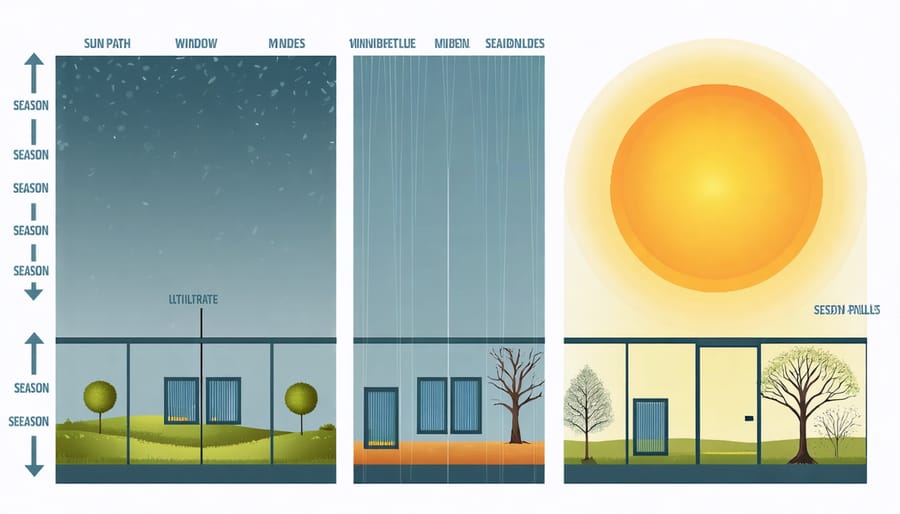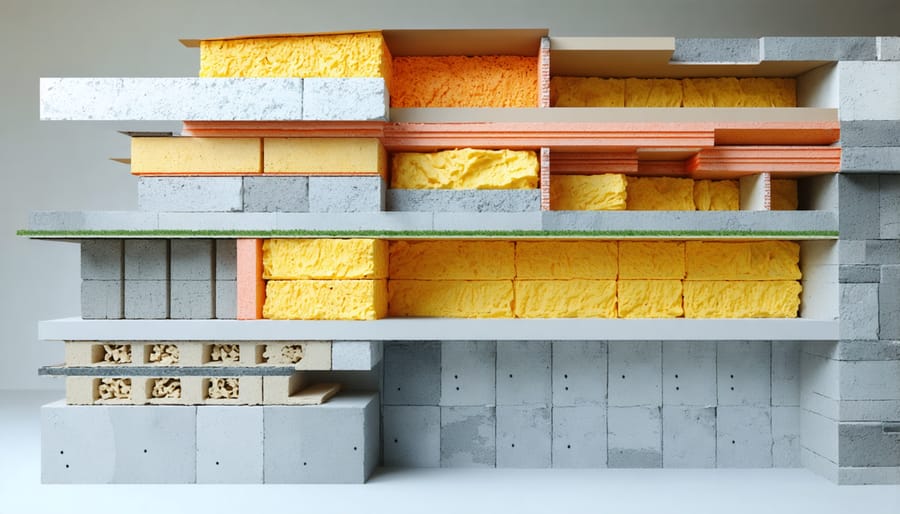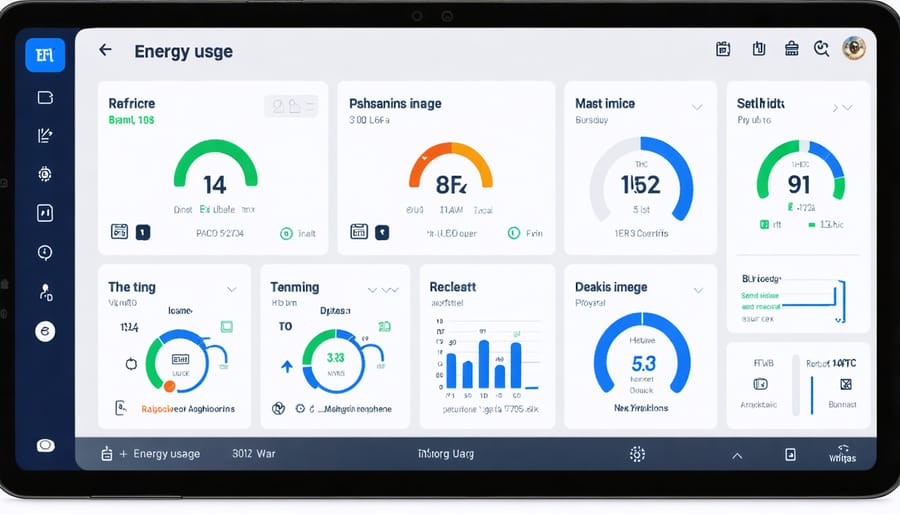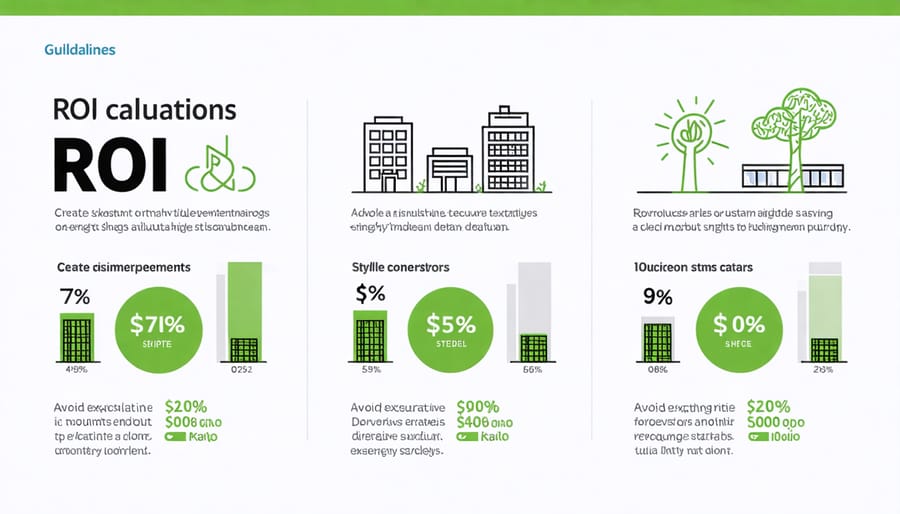Transform your home into an energy-efficient sanctuary by implementing strategic upgrades that slash utility bills while enhancing comfort. Installing programmable thermostats and smart home systems can reduce energy consumption by up to 15% annually through automated temperature control. Upgrade to ENERGY STAR certified appliances and LED lighting fixtures to immediately cut electricity usage by 30-80% compared to traditional options. Maximize natural climate control through zero energy home design principles: strategically place windows for cross-ventilation, install proper insulation, and use thermal mass materials to regulate indoor temperatures naturally. These practical modifications not only decrease your carbon footprint but also create a more comfortable living space while delivering substantial long-term savings on energy costs.
Passive Design Elements That Work While You Sleep
Strategic Window Placement and Design
Strategic window placement can dramatically impact your home’s energy efficiency, and it’s easier than you might think to make smart choices. Let’s start with orientation: south-facing windows are your best friends in cooler climates, as they allow maximum sunlight and heat during winter months. For optimal results, aim to have most of your windows facing south, with limited openings on the north side.
Double-pane or triple-pane windows are worth the investment, offering superior insulation compared to single-pane alternatives. These modern windows create an insulating air pocket that helps maintain indoor temperatures year-round. Consider low-E glass coatings, which reflect heat while allowing natural light to pass through – perfect for keeping your home cooler in summer and warmer in winter.
To manage solar gain effectively, think about external shading options. Adjustable awnings, pergolas, or deciduous trees can provide shade during hot summer months while allowing beneficial sun exposure in winter. For existing windows, solar films or thermal curtains offer cost-effective solutions for better temperature control.
Don’t forget about window size and placement height. Large windows should be positioned to maximize natural light without creating excessive heat gain. In two-story homes, consider clerestory windows – high windows that help vent warm air while drawing in natural light. For ventilation, positioning windows on opposite sides of rooms creates effective cross-breezes, reducing the need for artificial cooling.
Remember to seal any gaps around window frames with weather stripping or caulk – even the most energy-efficient windows won’t perform well if air is leaking around the edges. These simple adjustments can lead to significant energy savings throughout the year.

Natural Ventilation Systems
Harnessing the power of natural airflow can significantly reduce your home’s energy consumption while creating a more comfortable living environment. By implementing smart natural cooling strategies, you can minimize your reliance on artificial cooling systems and cut down on energy bills.
Cross-ventilation is your best friend when it comes to natural cooling. Start by identifying your home’s prevailing wind patterns and strategically opening windows on opposite sides of your living space. This creates a natural air current that pushes warm air out while drawing cooler air in. For maximum efficiency, position larger windows on the windward side of your home and smaller ones on the leeward side to increase air velocity.
Consider installing window awnings or overhangs above south-facing windows to block intense summer sun while still allowing winter warmth. Casement windows, which open like doors, are particularly effective at catching and directing breezes into your home. For two-story homes, take advantage of the stack effect by opening upper-level windows to let hot air escape while keeping lower windows open for cool air intake.
Don’t forget about your outdoor spaces! Strategic placement of trees and shrubs can create natural windbreaks and shade, enhancing your ventilation system’s effectiveness. Indoor features like ceiling fans can work alongside natural ventilation to improve air circulation without significant energy use.
For best results, open your windows during cooler morning and evening hours, and close them when outdoor temperatures peak. This simple routine helps maintain comfortable indoor temperatures naturally, reducing the need for air conditioning and saving energy throughout the warm season.
Smart Material Choices That Pay For Themselves
High-Performance Insulation Solutions
When it comes to maximizing your home’s energy efficiency, effective home insulation is your best friend. Today’s advanced insulation solutions offer incredible performance while being more eco-friendly than ever before.
Let’s explore some of the most effective options available:
Spray Foam Insulation
This modern marvel creates an airtight seal that can reduce energy costs by up to 50%. Available in both open-cell and closed-cell varieties, spray foam expands to fill every nook and cranny, making it perfect for irregularly shaped spaces and existing walls.
Mineral Wool (Rockwool)
Made from recycled materials, mineral wool offers excellent fire resistance and sound dampening properties. It’s naturally moisture-resistant and can be installed without protective gear, making it a favorite among DIY enthusiasts.
Cellulose Insulation
Perfect for environmentally conscious homeowners, cellulose is made from recycled paper products treated with fire-retardant materials. It can be blown into existing walls and attics, making it an excellent retrofit solution.
Polyisocyanurate (Polyiso) Boards
These rigid foam boards offer one of the highest R-values per inch of any insulation material. They’re ideal for new construction and major renovations, particularly in roofs and exterior walls.
Pro Tips for Maximum Effectiveness:
– Focus on your attic first – it’s where most heat loss occurs
– Don’t forget about pipes and ductwork
– Consider combining different types of insulation for optimal results
– Always ensure proper ventilation to prevent moisture issues
Remember, proper installation is crucial for any insulation to perform at its best. While some options are DIY-friendly, others might require professional installation. The initial investment in quality insulation typically pays for itself through energy savings within 3-5 years.

Energy-Efficient Roofing and Siding
Your home’s exterior plays a crucial role in energy efficiency, and choosing the right roofing and siding materials can significantly impact your heating and cooling costs. Let’s explore some smart choices that can help you create a more energy-efficient home envelope.
For roofing, cool roofs are gaining popularity for good reason. These materials reflect more sunlight and absorb less heat than traditional roofing, potentially reducing your cooling costs by 15-25% during summer months. Consider light-colored shingles, metal roofing with reflective coatings, or specialized cool roof tiles. Metal roofs are particularly effective, lasting up to 50 years while reflecting solar radiation and reducing heat transfer into your living space.
When it comes to siding, insulated vinyl siding is a game-changer. This material combines traditional vinyl’s durability with built-in foam insulation, creating an additional thermal barrier around your home. Fiber cement siding is another excellent option, offering superior insulation properties while maintaining a classic look.
Here are some key features to look for in energy-efficient exterior materials:
– Solar reflectance (ability to reflect sunlight)
– Thermal emittance (how readily the material releases absorbed heat)
– Insulation R-value (resistance to heat flow)
– Durability and weather resistance
Don’t forget about proper installation and maintenance. Even the most energy-efficient materials won’t perform optimally if they’re not installed correctly or maintained regularly. Consider scheduling annual inspections to check for damage or wear that might compromise your home’s energy efficiency.
Pro tip: Look for ENERGY STAR certified roofing materials, which meet strict energy efficiency guidelines set by the EPA. These products can help reduce peak cooling demand by 10-15%, leading to significant energy savings over time.
Remember that while energy-efficient roofing and siding materials might cost more upfront, the long-term savings on your energy bills often make them a smart investment. Plus, many local utilities and governments offer incentives for installing energy-efficient exterior materials, helping offset initial costs.
Automated Systems That Maximize Savings
Smart HVAC Controls
Smart HVAC controls are revolutionizing how we manage our home’s climate while significantly reducing energy consumption. At the heart of this technology are programmable thermostats, which allow you to create customized temperature schedules that align with your daily routines.
Instead of keeping your home at a constant temperature all day, these smart devices automatically adjust based on when you’re home, asleep, or away. For instance, you can program your thermostat to lower the temperature by 8-10 degrees while you’re at work and automatically warm things up just before you return. This simple adjustment can save you up to 10% annually on your heating and cooling costs.
Modern smart thermostats take this convenience even further by learning your preferences over time and making automatic adjustments. Many can be controlled remotely through smartphone apps, allowing you to modify settings when plans change unexpectedly. Some models even provide detailed energy usage reports and suggestions for optimizing your settings.
Zoning systems represent another significant advancement in HVAC control. These systems divide your home into different zones, each with its own temperature control. This means you can keep your bedroom cool at night while avoiding wasting energy heating or cooling unused spaces. Zoning is particularly valuable in homes with multiple stories, large open spaces, or rooms that receive different amounts of sunlight throughout the day.
To maximize the benefits of smart HVAC controls:
1. Place thermostats away from direct sunlight, drafts, or heat sources for accurate readings
2. Set temperature differentials of 5-8 degrees between occupied and unoccupied periods
3. Use the “auto” fan setting instead of “on” to reduce unnecessary air circulation
4. Take advantage of scheduling features for both weekdays and weekends
5. Consider occupancy sensors that automatically adjust settings based on room usage
Remember to regularly update your temperature schedules as seasons change and your routines shift. Many homeowners find that combining smart thermostats with zoning systems provides the perfect balance of comfort and energy efficiency, often paying for themselves through reduced utility bills within two years.

Lighting Automation
Transforming your home’s lighting system into an intelligent, energy-saving setup is easier than ever with today’s automation technologies. By implementing smart energy-efficient lighting solutions, you can significantly reduce your electricity consumption while enhancing your home’s comfort and convenience.
Motion sensors are a game-changer for spaces like hallways, bathrooms, and outdoor areas. These clever devices ensure lights only operate when someone’s present, eliminating the worry of forgotten switches and wasted energy. Installing motion sensors in less-frequented areas can cut lighting costs by up to 30% in those spaces.
Smart timers offer another layer of automation by scheduling your lights to match your daily routine. Set your outdoor lights to activate at sunset and switch off at sunrise, or program indoor lights to gradually brighten in the morning and dim in the evening. This natural rhythm not only saves energy but also supports your body’s circadian rhythm.
Smart bulbs represent the pinnacle of lighting automation. These WiFi-enabled marvels can be controlled through your smartphone or voice commands, allowing you to adjust brightness levels, change colors, and create custom lighting scenes. Many smart bulbs also include features like:
• Automatic dimming based on natural light levels
• Vacation mode that mimics occupancy
• Integration with other smart home devices
• Energy usage tracking and reporting
For maximum efficiency, combine these technologies strategically. Place motion sensors in transitional spaces, use timers for predictable lighting needs, and install smart bulbs in frequently used areas where flexibility is important. Remember to choose LED options for all automated lighting to multiply your energy savings.
Start small by automating one room or area, then expand your system as you become comfortable with the technology. The initial investment in automation equipment typically pays for itself within 12-18 months through reduced energy costs and extended bulb life.
ROI-Focused Energy Solutions
When it comes to investing in cost-effective energy upgrades, it’s essential to understand which improvements offer the best return on investment (ROI). Let’s break down some of the most financially rewarding energy-saving solutions and their typical payback periods.
LED lighting conversion typically pays for itself within 6-12 months, making it one of the quickest ROI winners. By replacing just ten traditional bulbs with LEDs, you can save around $75 annually on your electricity bill while enjoying bulbs that last up to 25 times longer.
Smart thermostats represent another excellent investment, with most units paying for themselves within two years. These devices can reduce heating and cooling costs by 10-15% annually, translating to average savings of $140-200 per year for the typical household.
Insulation improvements, while requiring a larger upfront investment, usually pay for themselves within 3-5 years. Adding proper insulation to your attic can slash heating and cooling costs by up to 15%, while also making your home more comfortable year-round.
Weather stripping and door seals are incredibly cost-effective, with payback periods of just a few months. These simple upgrades can reduce heating and cooling costs by 5-10% by preventing drafts and air leaks.
For those considering bigger investments, solar panels typically have a payback period of 5-10 years, depending on your location and energy usage. With many systems lasting 25-30 years, you’ll enjoy free electricity for decades after reaching the break-even point.
Energy-efficient appliances might cost more initially, but their reduced operating costs mean most pay for themselves within 3-7 years. Look for ENERGY STAR certified models, which use 10-50% less energy than standard appliances.
Remember, many of these improvements qualify for tax incentives or utility rebates, which can significantly reduce your initial investment and accelerate your payback period. Always check local programs before starting any energy-saving project.

As we’ve explored throughout this guide, implementing energy-saving strategies in your home doesn’t have to be overwhelming or expensive. By starting with simple changes like updating your window treatments and sealing air leaks, you can begin seeing immediate improvements in your energy consumption. Remember that combining multiple approaches – from passive design elements to smart technology – creates the most effective energy-saving solution for your home.
The key is to start small and build up gradually. Begin with the low-hanging fruit: LED bulbs, programmable thermostats, and proper insulation. As you become more comfortable with these changes, consider larger investments like energy-efficient appliances or solar panels, which can offer substantial long-term savings.
Don’t forget that seasonal adjustments play a crucial role in your energy-saving strategy. What works in summer might need tweaking for winter, so stay flexible and attentive to your home’s changing needs throughout the year.
Most importantly, remember that every small change counts. Whether you’re implementing one strategy or several, you’re not just reducing your energy bills – you’re contributing to a more sustainable future. Start today with whatever modifications fit your budget and lifestyle, and build upon your success as you go. Your wallet – and the planet – will thank you for it.
